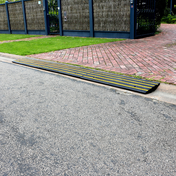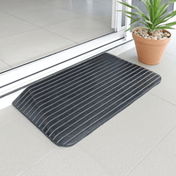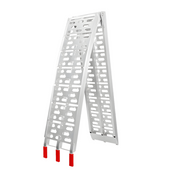You’re halfway up the ramp, mower humming beneath you, and then…you feel it.
A little bounce. A subtle dip. Maybe even a slight wobble.
Your first thought? “Wait... is this supposed to happen?”
If you’ve ever loaded a mower, quad bike, or ATV and felt your aluminium ramps flex, you’re not alone. It’s a common experience, but also one that can cause a bit of anxiety if you’re not sure what’s normal.
So let’s clear the air. In this guide, we’ll explain:
- Why do aluminium ramps flex
- When it’s totally fine (and when it’s not)
- How to make your loading setup safer and more stable
No matter if it’s for work or play, here's what you need to know to stay confident and in control.
What Makes Aluminium Ramps So Popular?
 Before we talk about movement and stability, let’s look at why aluminium is the go-to material for loading ramps across the country.
Before we talk about movement and stability, let’s look at why aluminium is the go-to material for loading ramps across the country.
1. Lightweight Yet Durable
Aluminium is a naturally light metal—perfect for anyone who needs to set up and pack down ramps regularly. You can easily carry one under your arm, load it in the tray, and get moving without breaking your back.
2. Rust-Resistant
Unlike steel, aluminium doesn’t rust. This makes it ideal for outdoor use, especially for tradies or riders who are exposed to the elements.
3. High Strength-to-Weight Ratio
Despite being light, aluminium has a surprisingly high load capacity when engineered correctly. Our aluminium ramps handle serious weight, ranging from 300kg up to 9000kg per pair. They’re lightweight, but far from flimsy.
4. Designed to Flex—Not Fail
This is where things get interesting. Aluminium, by nature, is more flexible than steel. And when that’s combined with smart design and structural welding, it creates a product that bends slightly under load, without breaking.
 In other words, if you feel a little flex in the ramp as you walk, ride or push up it, that’s by design.
In other words, if you feel a little flex in the ramp as you walk, ride or push up it, that’s by design.
Is Wiggle in Aluminium Loading Ramps Normal?
Short answer: YES
When a ramp flexes slightly, it’s not a flaw—it’s a feature. Here's why:
- Flex helps distribute weight
- It cushions the impact from rolling or riding loads
- It reduces long-term stress on welds and joints
Think of it like a suspension bridge—it sways slightly under load to prevent cracks. Rigid structures often fail under pressure. Aluminium ramps are engineered with just enough flex to work smarter, not harder.
When Wiggle Becomes a Worry
Not all movement is good. Here’s when it’s time to stop and reassess:
 1. You’re Over the Load Limit
1. You’re Over the Load Limit
Every ramp has a safe working load (SWL), and exceeding it is a fast track to damage or injury.
✅ Know your machine’s wet weight (including rider or cargo)
✅ Match it to the ramp’s max load rating (listed on every Ramp Champ product page)
2. The Ramp is Too Short
Short ramps create steep angles, which means more flex and stress.
If the ramp is too short for the height of your tray or trailer, you’ll end up with a steep angle. This puts unnecessary stress on the middle of the ramp—that’s when you’re likely to notice excessive bounce or instability, both red flags.
Pro Tip: Use our Ramp Calculator to find the right length for your loading height.
3. Soft or Uneven Ground
Setting up a ramp on grass, dirt, or gravel? That’s a recipe for imbalance. Always place ramps on level, solid ground for maximum stability.
4. You’re Using the Wrong Ramp
A narrow dirt bike ramp might work great for two wheels, but it’s not going to cut it for a quad bike or mower. Wider vehicles require wider ramps, equipped with crossbar traction and side safety rails.
5. Unsecured Ramps
This one’s crucial: never load without anchoring your ramp. If the top of your ramp isn’t pinned, strapped, or clipped to the vehicle or trailer, it can slip out mid-load. It’s not just a hazard—it’s how serious accidents happen.
In summary, while some minimal wiggling or movement in aluminium ramps is normal due to their lightweight and portable nature, it should be controlled and limited by proper installation, secure anchoring, and adherence to safety guidelines.
Significant or uncontrolled wiggling is a sign of risky conditions or design/installation issues that must be addressed to ensure safe use.
How to Make Aluminium Ramps More Stable
Now that we know what to watch out for, let’s talk about solutions. These accessories and setup tips can help eliminate risky movement and give you full peace of mind while loading.
1. Add Support Legs
Many professional-grade ramps come with adjustable support legs. These provide extra stability at the midpoint of the ramp, especially useful for longer ramps or heavier machinery.
Best for:
✔ Commercial equipment
✔ Ride-on mowers
✔ Site trailers and utes
2. Choose the Right Ramp Length
Short ramps = steep angles. And steep angles = more bounce.
As a general rule of thumb:
-
For a 500mm height, go for a 1500mm ramp
-
For 700mm, go for at least 2100mm
- For 1,000mm or higher, aim for 2400mm+

Longer ramps distribute load better and reduce the bend, making them safer and more stable, especially for heavier equipment or when loading alone.
Most manufacturers and industry guidelines advise keeping the ramp slope below 20% (1:5 gradient) for safe loading and unloading of vehicles and heavy equipment.
Some heavy-duty aluminium ramps can handle a maximum slope of 30% (about 1:3.3), but this is generally considered steep and riskier, particularly for wheeled vehicles or wet surfaces.
Practical Example
- A popular size for loading cars or 4WDs is a 3.5m x 450mm aluminium ramp, rated up to 4 tonnes per pair.
- If your loading height is 500 mm, a 3500 mm ramp gives a slope of about 14%, which is within safe limits for many applications.
3. Match the Ramp Width to the Vehicle
Trying to ride a 4-wheeler up two slim moto ramps? You’re setting yourself up for trouble. Quads, ATVs, and side-by-sides need extra-wide ramps or twin ramps spaced to the tyre track width.
We recommend:
-
Single-wide ramps for motorbikes and scooters
-
Twin-runner ramps for ATVs and ride-ons
-
Folding wide ramps for those needing more versatility
4. Always Strap It Down
Even the most advanced ramp is only as good as its anchoring.
To prevent movement during loading, we always recommend securing your ramp using appropriate safety equipment. Depending on your setup, this might include:
- Looping a strap through the ramp’s top hook and the trailer rail
- Using a ramp clamp or lock pin if your tray has compatible mounting points
 Frequently Asked Questions (FAQs)
Frequently Asked Questions (FAQs)
Are aluminium ramps safe for heavy equipment?
Yes—when used within their rated capacity and with proper setup, aluminium ramps are extremely safe and long-lasting.
What’s the ideal length for ute ramps?
The ideal ramp length depends on the height of your tray or trailer and the type of equipment or vehicle you’re loading. As a general rule, longer ramps create a gentler incline, which improves traction, reduces bounce, and minimises risk. Please check our guide.
Can I use one ramp for different vehicles?
Yes, but only if the ramp is rated and sized appropriately for each. For mixed use, opt for a wider or heavy-duty option.
Are aluminium ramps slippery when wet?
Aluminium ramps can be slippery in wet conditions, especially if they have a smooth surface. That’s why many quality ramps feature raised tread patterns, grip bars, or serrated rungs to improve traction. For safer use in the wet, always choose a ramp with anti-slip features and ensure it’s clean, secure, and on solid ground before loading.
How long do aluminium ramps last?
With proper use and care, aluminium ramps can last many years, even with regular, heavy-duty use. They’re rust-resistant and designed to handle repeated loading, but longevity depends on factors like load weight, frequency of use, and whether they’re stored in dry, protected conditions. Inspect your ramp regularly to catch any early signs of wear.
Final Thoughts: Built to Bend, Engineered for Safety
Aluminium loading ramps aren’t faulty because they move—they’re smartly engineered to flex. That little wiggle you feel is a sign the ramp is working to protect you, your gear, and your vehicle.
But like any gear, they need to be used the right way.
✅ Choose the right ramp for the job
✅ Support it properly
✅ Load on level ground
✅ Strap it down
✅ Never exceed the load rating
Follow these steps, and your aluminium ramp becomes a reliable mate from the job site to the trails.
Explore our aluminium loading ramps today to find the perfect solution for your needs.





